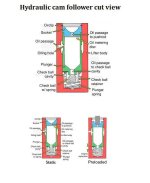First, let me back here.
I'm assuming that "contender31" is wanting a rocker arm/cam follower adjustment procedure since it's rather unclear in post #1.
But I agree:
I also have used RIck's rotate the crank a bunch and do it right method, and for half a century! That BS saying you can adjust all the valves in a V-8 by putting it in only two rotations is nuts! Why? 'Cause it's extremely easy to mistake a, say, 4E for a 4I rocker, and that can be disatrous!
Not just that alone!
With the 8 stop procedure @ TDC C/S, we pretty much ensure that the cam follower is at the base circle low point.
The difference is only 6 more stops..... and is hardly anything to sweat over. :rolleyes:
Jeff, good to hear that you're on board with this.
This silly 2 and 3 stop procedure can be found in OEM manuals, if you can believe that!

Sheesh!
I've argued and debated this many times over the years. In some 47/48 years, I have NEVER used anything but the 8 stop procedure. I can almost guarentee that anyone using the 2 or 3 stop, will be going back through these dynamically.
Nothing wrong with doing these dynamitcally, but when the 8 stop is used correctly, we'll seldom find ourselves going back through them.
I'll go one further if you'll bear with me:
When assembling a fresh engine, I do this procedure prior to the intake manifold being installed, and prior to priming the oil system.
With the cam followers not yet having oil in them, the plunger is free to move within the cam follower body.
This allows us to view the push-rod cup (aka socket) as it as we reach ZERO lash.
If we look closely, we can see when the plunger just begins to move away from the cup retainer clip.
I've always viewed this method as being more accurate.
But each to his own!

Here's a neat little
GIF file that shows a cam follower just prior to oil pressure, and then after oil pressure.
Note that the plunger is free to travel fully prior to oil and/or oil pressure.
(on average, plunger travel is approximately .100" +/- ..... our goal is setting the plunger depth as per the OEM engineers)
Once oil pressure is realized, the plunger is now subject to the cushion of oil.


